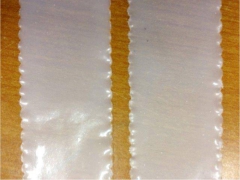At the 251st National Meeting & Exposition of the American Chemical Society (ACS) earlier this month, scientists from Tuskagee University (Alabama, USA) presented the results of a study on the use of eggshell in bioplastic.
The idea is to create a new kind of biodegradable packaging material that bends but does not easily break.
 “We’re breaking eggshells down into their most minute components and then infusing them into a special blend of bioplastics that we have developed,” said Vijaya K. Rangari, Ph.D, a professor in the Department of Materials Science and Engineering. Rangari is the principal investigator for a $1 million National Science Foundation grant to study and create new products made from natural waste. The co-principal investigators are Drs. Shaik Jeelani, Mahesh Hosur, Temesgen Samuel and Shaik Zainuddin.
“We’re breaking eggshells down into their most minute components and then infusing them into a special blend of bioplastics that we have developed,” said Vijaya K. Rangari, Ph.D, a professor in the Department of Materials Science and Engineering. Rangari is the principal investigator for a $1 million National Science Foundation grant to study and create new products made from natural waste. The co-principal investigators are Drs. Shaik Jeelani, Mahesh Hosur, Temesgen Samuel and Shaik Zainuddin.
Why eggshell? “These nano-sized eggshell particles add strength to the material and make them far more flexible than other bioplastics on the market. We believe that these traits — along with its biodegradability in the soil — could make this eggshell bioplastic a very attractive alternative packaging material,” explained Rangari.
To date, most of the compostable and biodegradable materials available today lack the strength and flexibility needed to work well in the packaging industry. Dr. Vijaya Rangari, working together with third-year graduate student Boniface Tiimob and other colleagues at Tuskegee University experimented different kinds of plastics. They eventually settled on a mixture of 70 percent polybutyrate adipate terephthalate (PBAT), a petroleum polymer, and 30 percent polylactic acid (PLA), a polymer derived from cornstarch. PBAT, unlike other oil-based plastic polymers, is designed to begin degrading as soon as three months after it is put into the soil.
This mixture had many of the traits that the researchers were looking for, but they wanted to further enhance the flexibility of the material. So they created nanoparticles made of eggshells. They chose eggshells, in part, because they are porous, lightweight and mainly composed of calcium carbonate, a natural compound that easily decays.
The shells were washed, ground up in polypropylene glycol and then exposed to ultrasonic waves that broke the shell fragments down into nanoparticles more than 350,000 times smaller than the diameter of a human hair. Then, in a laboratory study, they infused a small fraction of these particles, each shaped like a deck of cards, into the 70/30 mixture of PBAT and PLA. The researchers found that this addition made the mixture 700 percent more flexible than other bioplastic blends. They say this pliability could make it ideal for use in retail packaging, grocery bags and food containers — including egg cartons.
In addition to bioplastics, Rangari’s team is investigating using eggshell nanoparticles to enhance wound healing, bone regeneration and drug delivery.
Source
Bioplastics MAGAZINE, 2016-03-25.
Supplier
American Chemical Society (ACS)
National Science Foundation (USA)
Tuskegee University
Share
Renewable Carbon News – Daily Newsletter
Subscribe to our daily email newsletter – the world's leading newsletter on renewable materials and chemicals













